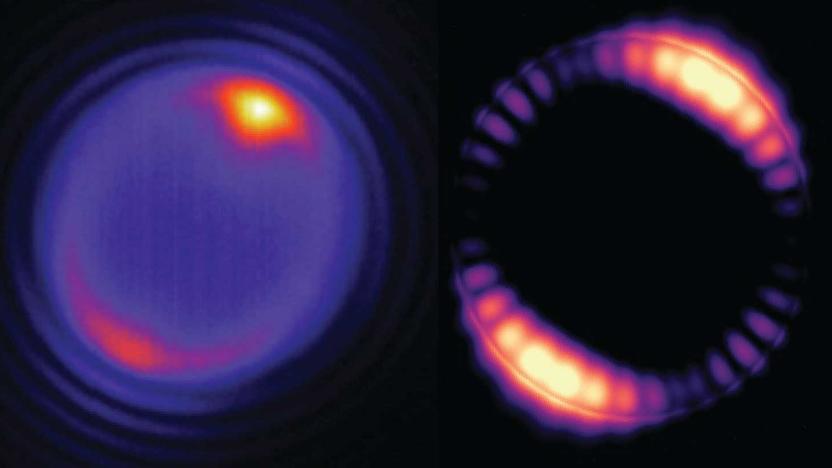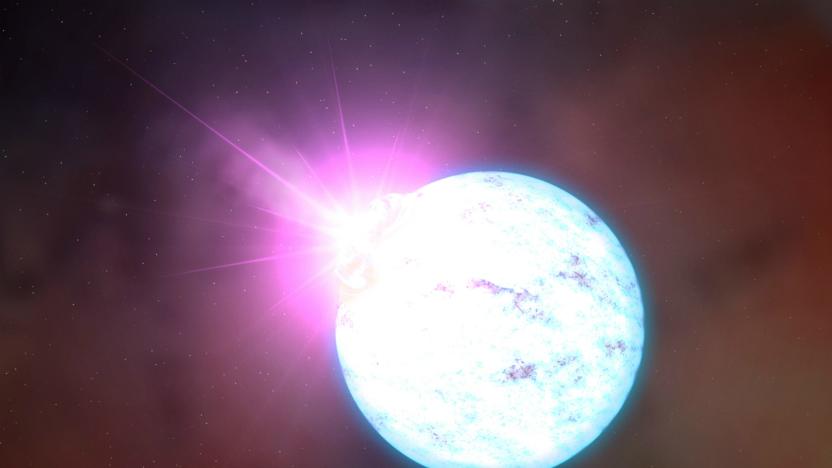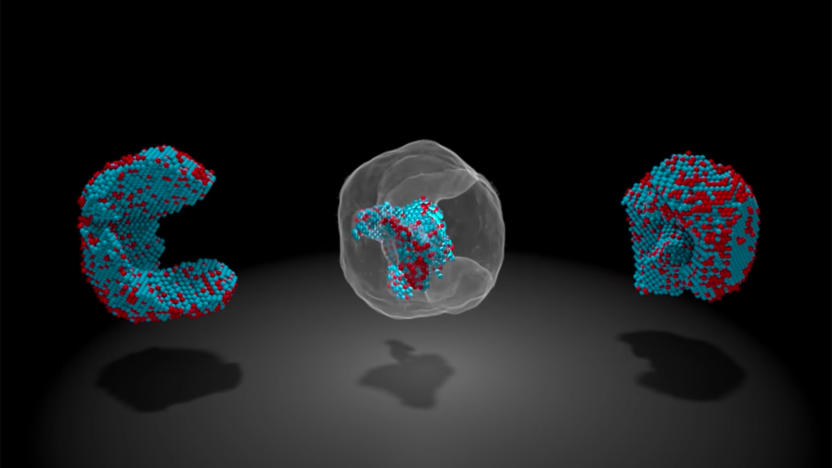BerkeleyLab
Latest

DNA synthesis breakthrough could lead to faster medical discoveries
For all of the advancements in genetic research, DNA synthesis hasn't changed much in over four decades. That could make it a serious obstacle to scientists who are otherwise racing to develop a new drug or understand the human body. It might finally catch up to modern technology, however. A group at the Berkeley-based BioEnergy Institute have devised a synthesis technique that promises to be faster, more accurate and affordable. If all goes smoothly, it could significantly accelerate the pace of medical and biochemical discoveries.

Cell-sized 'microlasers' could regulate brain activity
Scientists have spent years creating ever-smaller lasers. Berkeley Lab's latest invention, however, is something special -- and could lead to a significant change in medicine. An international team at the school has developed "microlasers" that are smaller than a red blood cell. The researchers discovered that 5 micron-wide polymer beads mixed with exotic nanoparticles (sodium yttrium fluoride infused with thulium) could reliably emit bright light on specific wavelengths when exposed to infrared light. The concoction makes light bounce around the inner surface of the bead, creating collisions that can repeatedly amplify the light -- it's similar to the "whispering gallery" effect that lets you hear a quiet sound across a giant space with the right acoustics.

Magic Leap is experimenting with light-bending nanomaterials
Mixed reality company Magic Leap is cagey with its tech, to say the least. However, it has released a research paper in conjunction with Berkeley Lab that hints on what it's doing. The team developed new materials that can take in light from more angles than before and redirect it with minimal losses. That could aid not only its mixed reality (MR) headset, which reportedly uses wave-guiding tech similar to the Hololens, but spark breakthroughs in holograms, invisibility cloaks and more.

New computer models could direct scientists to epic cosmic events
Now that they're spotting gravitational waves more often, scientists are expanding their search for cosmic events. Specifically, they're using new computer models to depict the cataclysmic collision that occurs when a black hole joins a neutron star (the remnants of an exploded star). The simulations will help detectors track down the actual mergers using telescopes and advanced versions of LIGO (the Laser Interferometer Gravitational-Wave Observatory).

Scientists map every atom inside a nanoparticle
Even the smallest defects can create serious problems. It's a good thing, then, that researchers have found a way to map nanoparticles at an "unprecedented" level of detail -- they've located the 3D positions of all 23,000 atoms in an iron-platinum particle. The group used an extremely high-resolution transmission electron microscope (TEAM I) to capture 2D projections of the nanoparticle's structure, and used an algorithm to stitch those together into a 3D reconstruction. If there's a missing or misplaced atom, you could easily spot it.

Self-driving taxis may be the key to cutting greenhouse gases
You may think that self-driving cars are mostly useful for reducing accident rates and freeing your time, but they might just help save the environment, too. Berkeley Lab researchers have published a study which suggests that switching the transportation grid from conventional vehicles to autonomous electric taxis would cut greenhouse gas emission levels up to 90 percent by 2030. While the clean EV powerplants would play a large part, the switch away from privately-owned cars that would make nearly as much of a difference. A big key would be "right-sizing" trips -- since you'd usually just need a tiny car to get around, you could avoid getting into a big vehicle until it's necessary. The base data doesn't even include some of the efficiencies that are inherent to robotic cars, like optimized routes and closely-packed traffic that cuts wind resistance.

Scientists take detailed pictures of the smallest known life forms
Just how small can life get? Almost unbelievably small, if you ask a team of Berkeley Lab researchers. They've taken the first detailed electron microscope pictures of the tiniest bacteria known to date -- at a typical 0.009 cubic microns in volume, you could fit 150 of them in an already miniscule e. coli cell. Scientists had to catch the hard-to-spot microbes by using a new portable cryo plunger, which flash-froze groundwater to near absolute zero (about -458F) to keep the cells intact while they were in transit.

A 3D slice of the universe 10.8 billion years ago
Mapping out the ancient universe is a major astronomical goal, but there's a huge challenge: the galaxies there are so dim, scientists can't make out any of the dark parts. But researchers from the Max Planck Institute and US Berkeley/Berkeley Lab have made a breakthrough that may help. They turned their telescopes on a small, 10.8 billion year old chunk of the universe, measuring the change in light from galaxies caused by hydrogen clouds just in front of them. By observing a number of such galaxies, the astronomers created a map of the cosmic web of gases in front of them, in a similar way that scientists map out the brain using CT scans. Though they covered just a tiny portion of the universe, the scientists think it could help the DESI project, due to come online in 2018. It's goal is nothing less than completely mapping the universe to a distance of 10 billion light years.

Scientists capture images of molecules forming atomic bonds
For most of us, molecular bonding only really exists as a classroom concept. Some scientists at Lawrence Berkeley National Laboratory can now claim more tangible knowledge, however: they're the first to have taken truly clear snapshots of bonding in progress. While trying to create graphene nanostructures and observe them with an atomic force microscope, a lab team spotted molecules forming their individual, atom-level links during a chemical reaction. The resulting shots were nearly textbook material, too -- as the molecules were neatly placed on a flat surface, the researchers identified the order and nature of each bond. While the images will only be immediately useful for the nanostructure research at hand, they may add a welcome dash of reality to future chemistry lessons.

Researchers make unsuitable parts work as solar cells, could lead to cheaper panels
Harnessing the power of the sun is a tricky business, but even the past few weeks have seen some interesting developments in the field. In this latest installment, researchers from the Lawrence Berkeley National Laboratory and the University of California have figured out a way of making solar cells from any semiconductor, potentially reducing the cost of their production. You see, efficient solar cells require semiconductors to be chemically modified for the current they produce to flow in one direction. The process uses expensive materials and only works with a few types of semiconductors, but the team's looking at using ones which aren't normally suitable -- the magic is to apply an electrical field to them. This field requires energy, but what's consumed is said to be a tiny fraction of what the cell's capable of producing when active, and it means chemical modification isn't needed. The concept of using a field to standardize the flow of juice isn't a new one, but the team's work on the geometrical structure of the cells has made it a reality, with a couple of working prototypes to satisfy the skeptics. More of these are on the way, as their focus has shifted to which semiconductors can offer the best efficiency at the lowest cost. And when the researchers have answered that question, there's nothing left to do but get cracking on commercial production. For the full scientific explanation, hit up the links below.

Cheap electronic skin edges us closer to cyberpunk future
Researchers working for the Department of Energy's Berkeley Lab have figured out how to create relatively inexpensive "electronic skin" comprising carbon nanotubes enriched with semiconductors. Their process involves an enriched single walled carbon nanotube (SWNT) solution embedded in a honeycomb pattern of hexagonal holes to make it more flexible and stretchable - it's so limber, they wrapped it around a baseball, as you can see in the photo above. Combined with inkjet printing of electrical contacts, the technology paves the way for making flexible, wearable computers and a host of other cool things that William Gibson and other cyberpunk authors thought of back in the 1980s: smart bandages, flexible solar cells and electronic skin that can sense touch. Bring on the Zeiss eye implants and neural interface jacks!

Researchers use graphene and tin sandwich to make better battery electrodes
Graphene, that microscopic chicken wire made of carbon atoms, has a great many theoretical uses. Among these is to improve Lithium-ion battery technologies, and the big brains at the Lawrence Berkeley National Laboratory have created a graphene and tin composite material for use in battery electrodes. When it's baked at 572 degrees Fahrenheit (300 degrees Celsius) the tin turns into nanopillars that widen the gap between the graphene layers. The greater volume of tin provided by these tiny towers improves electrode performance (read: faster charging), and the flexibility of the graphene prevents electrode degradation. Naturally, current prototypes can only maintain capacity over 30 charge cycles -- as opposed to the hundreds required for commercial applications -- so some serious improvement has to happen before we see it strut its stuff in any phones or EVs. This leaves us, once again, extolling the virtues of graphene, but lamenting its exclusively academic application.

Berkeley Lab scientists create nanocrystal hydrogen storage matrix, could make for H2 batteries
If you could run your celly on hydrogen you'd have power for days and days -- but, you'd also need to lug around a high-pressure tank to store the stuff. That's no fun, and that's why we're still using Li-ion batteries and the like. But, scientists at the Lawrence Berkeley National Laboratory look to have found a way to possibly ditch the tank, creating a gas-barrier polymer matrix out of polymethyl methacrylate, allowing the H2 gas in but keeping oxygen and everything else out. That matrix contains magnesium nanocrystals that react with the hydrogen to form MgH2, enabling safe, (relatively) low-pressure storage. The H2 can then be released again and the magnesium nanocrystals are freed to bond with another batch of H2 when refilled. It sounds a little like the Cella Energy hydrogen storage solution, but a bit more promising if we're honest. Now for the long, painful wait for this to come to production.

Nanoscale ropes braid themselves, tiny sailors still needed to tie tiny knots
While perhaps not being quite as useful as towels, ropes are might handy things to have. With them you can attach things to other things and, well, that's really their primary use. But what if those things are small? Really small. You need nanoropes of the sort created at the Molecular Foundry, braids that measure just 600 nanometers in diameter. A sheet of paper? About 100,000 nanometers thick. Perhaps even more interesting than their scale is how they were constructed, formed of polypeptoids that self-assemble into the coiling double helix you see above. Possible uses? Right now this is a part of experiments to create more complex nanoscale structures, but we could totally see them being used to, you know, tie tiny things together.






